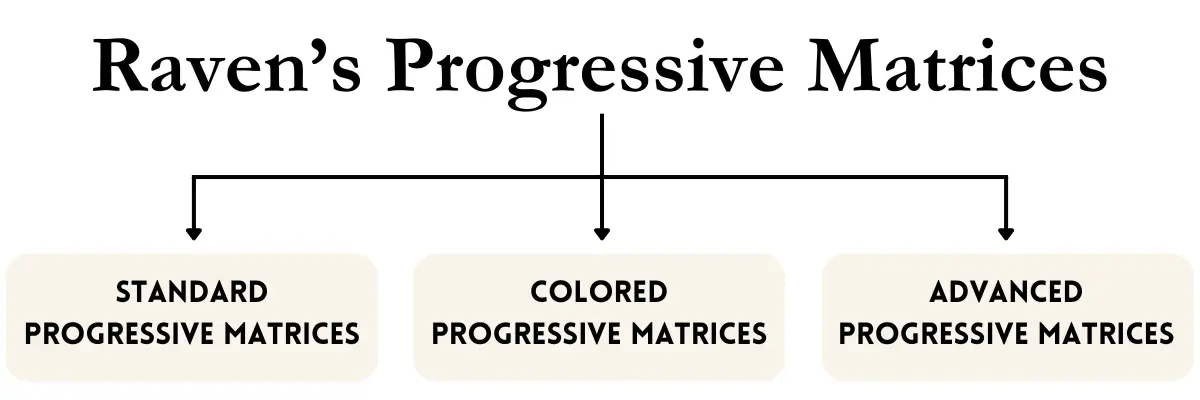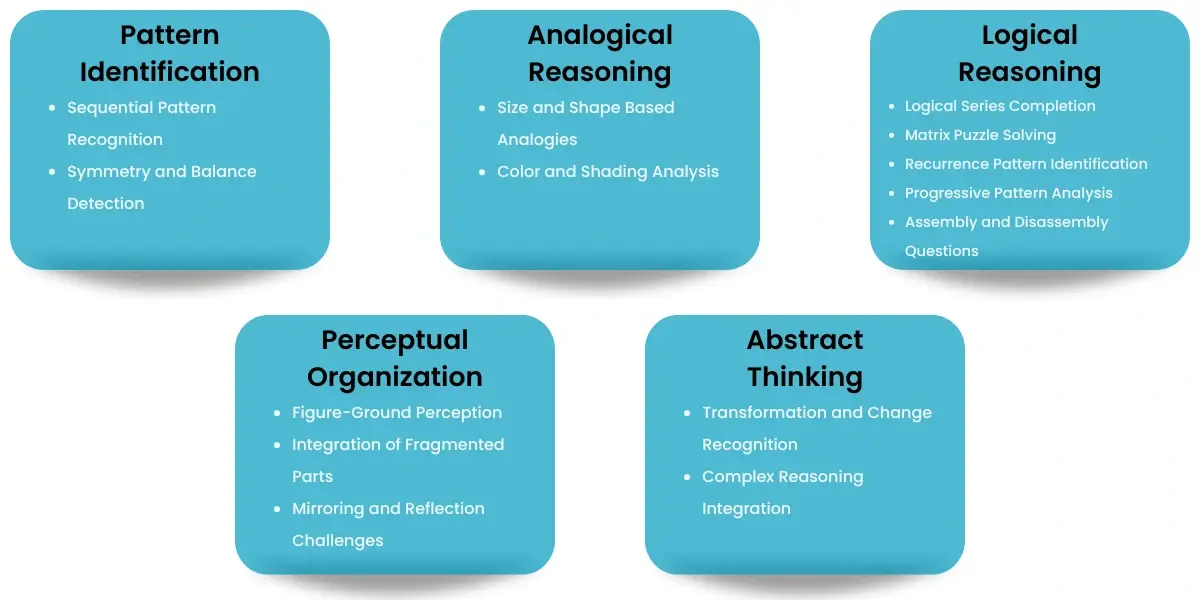Raven’s Advanced Progressive Matrices Prep - Study Guide & Practice Test for 2025
- Overview
- Practice Test
- Question Types
- Curriculum
Raven’s Progressive Matrices (RPM) is a cutting-edge assessment tool designed to assess abstract reasoning and problem-solving skills. It is especially relevant for those aspiring to higher-level positions, where the Advanced Progressive Matrices (APM) version is often used in pre-hiring evaluations to discern candidates’ potential for leadership and complex analytical roles.
Navigating this test can seem overwhelming, but our detailed course on RPM, with an emphasis on the Advanced Progressive Matrices, provides a clear path through the complexities of the assessment. Our goal is to provide you with a thorough understanding of the test’s background, its methodologies, and its practical implications in the professional sphere. Through engaging materials and challenging exercises, we aim to deepen your comprehension and enhance your problem-solving skills.
Let’s begin by understanding what RPM is all about.

Raven’s Advanced Progressive Matrices Test
Last Updated: Jan 07, 2025
Course Content
 Introduction2 steps - 15 minutesBuy this Course: Get full access to all lessons, practice tests and guides.
Introduction2 steps - 15 minutesBuy this Course: Get full access to all lessons, practice tests and guides. Understanding the versions of RPM1 Step - 35 MinutesBuy this Course: Get full access to all lessons, practice tests and guides.
Understanding the versions of RPM1 Step - 35 MinutesBuy this Course: Get full access to all lessons, practice tests and guides. Exploring the type of questions1 Step - 50 MinutesBuy this Course: Get full access to all lessons, practice tests and guides.
Exploring the type of questions1 Step - 50 MinutesBuy this Course: Get full access to all lessons, practice tests and guides. Effective Tips and Strategies1 Step - 30 MinutesBuy this Course: Get full access to all lessons, practice tests and guides.
Effective Tips and Strategies1 Step - 30 MinutesBuy this Course: Get full access to all lessons, practice tests and guides. Scoring & Reporting1 Step - 30 MinutesBuy this Course: Get full access to all lessons, practice tests and guides.
Scoring & Reporting1 Step - 30 MinutesBuy this Course: Get full access to all lessons, practice tests and guides. Raven's - Practices QuizzesBuy this Course: Get full access to all lessons, practice tests and guides.
Raven's - Practices QuizzesBuy this Course: Get full access to all lessons, practice tests and guides.
What is Raven’s Progressive Matrices Test?
Developed by John C Raven, RPM is a non-verbal test that assesses fluid intelligence, which refers to the ability to reason and solve unfamiliar problems without relying on previously acquired knowledge.
The test is notably free from linguistic and cultural biases, making it an attractive option for employers seeking to evaluate cognitive abilities across diverse populations. It uses visual geometric puzzles to assess intelligence without the need for language.
Take a look at the key features of the assessment:
| Time | The duration of the test varies depending on which version is administered. |
|---|---|
| Format | It features a nonverbal, multiple-choice format with visual geometric puzzles. |
| Question Structure | Puzzles include a matrix or grid with one geometric design missing. The challenge is to choose the correct piece to complete the matrix. |
| Purpose of the Test | The test aims to evaluate cognitive abilities to determine job suitability. |
| Versions of the Test |
|
| Administration | It can be given to individuals or groups and is available in both paper and digital formats. |
Practice for Raven Advenced Progressive Matrices Now
Variations of RPM
There are three versions of the Raven’s Progressive Matrices, each designed to cater to different levels of cognitive abilities.

Standard Progressive Matrices (SPM)
The initial version intended for the general public, SPM evaluates non-verbal, abstract, and cognitive skills, crucial aspects of general intelligence. This version is usually used for entry-level roles.
It contains five sets, labeled A to E, with each set containing 12 questions, giving a total of 60 questions. The items are presented in black ink on a white background and progressively increase in difficulty within and across the sets.
Colored Progressive Matrices (CPM)
The Colored Progressive Matrices (CPM) are designed for children aged 5-11, the elderly, and individuals with learning difficulties, to identify learning and developmental delays. It is also used for patients with brain injuries or dementia.
The test, with brighter colors and simpler patterns, includes three sets (A, Ab, and B) of 12 items each. Items in the exam are created specifically to be more visually stimulating than other versions of the Raven test. Each graphic involves an array of colors, distinctly set against a bright background. However the last few items in set B are presented as black-on-white; in this way, if a subject exceeds the tester’s expectations, the transition to sets C, D, and E of the standard matrices is eased
Advanced Progressive Matrices (APM)
The Advanced Progressive Matrices (APM) are designed for scenarios requiring high-level cognitive abilities, such as problem-solving and strategic thinking. They are used in higher education admissions and for selecting employees in intellectually demanding roles.
Aimed at adults and adolescents with above-average intelligence, the APM is divided into two sets: Set I with 12 practice items, and Set II with 36 main test items, which are more challenging than those in the Standard Progressive Matrices (SPM). Items are presented in black ink on a white background and become increasingly complex as progress is made through each set.
Structure of Questions
The test consists of visual geometric puzzles within a matrix (4×4, 3×3, or 2×2), where a piece is missing, requiring participants to select the correct option from several provided. The questions are designed to assess various aspects of visual and logical reasoning skills and can fall into the below-mentioned categories:

Let’s quickly look at the question types in brief:
- Sequential Patterns: Recognize sequence in patterns, assessing logical order discernment.
- Symmetry Detection: Identify symmetrical patterns to improve spatial and geometric skills.
- Size/Shape Analogies: Grasp analogies involving size and shape changes, emphasizing proportion understanding.
- Color/Shading Analysis: Discern patterns in color gradations, testing color perception.
- Matrix Puzzles: Understand matrix logic to complete puzzles, testing visual-spatial reasoning.
- Recurring Patterns: Spot repeated elements to decode sequences.
- Progressive Patterns: Test ability to anticipate element trends.
- Assembly/Disassembly: Build or break down figures to find missing components, assessing spatial skills.
- Figure-Ground Perception: Distinguish main figures from backgrounds, enhancing focus.
- Fragment Integration: Understand how parts form a whole, highlighting holistic processing.
- Mirroring/Reflection: Comprehend symmetrical and mirrored patterns.
- Pattern Shifting: Deal with shape dynamics and movements, understanding visual changes.
- Transformation Recognition: Understand shape transformations, assessing adaptability.
- Revolution Analysis: Comprehend figure rotation, testing spatial orientation.
- Complex Reasoning: Combine reasoning types for complex puzzle-solving, and testing integration skills.
How are the Results Evaluated?
RPM now uses theta scores (-4 to +4) instead of simple correct answer counts, offering a detailed evaluation by considering accuracy, question difficulty, and discrimination ability. These are converted to percentile ranks to compare performance among peers, addressing the limitations of raw scores by factoring in question complexity and distinguishing between different levels of cognitive ability. It emphasizes the importance of integrating these scores with other factors like emotional intelligence and job-specific skills for a rounded assessment.
For practical reasons, scores are often grouped and interpreted based on certain percentages of the population, as outlined below:
| Grade | What does it Signify? | Percentile Range |
|---|---|---|
| Grade I | Intellectually superior | If the score lies at or above the 95th percentile |
| Grade II | Above Average | If the scores lie at or above the 75th percentile. |
| II+ | If the score lies at or above the 90th percentile | |
| Grade III | Intellectually Average | If the score lies between the 25th and 75th percentile |
| III+ | If the scores are greater than the 50th percentile | |
| III- | If the scores are less than the median | |
| Grade IV | Below Average | If the scores lie at or below the 25th percentile |
| IV- | Scores below the 10th percentile | |
| Grade V | Intellectually Impaired | If the score lies at or below the 5th percentile |
Take a look at why Prepterminal Raven’s Progressive Matrices course is the right choice for you.
Why go for the Prepterminal Prep Course?
Prepterminal offers a module-based Raven’s Advanced Progressive Matrices (RAPM) Prep Course with comprehensive study guides and practice tests. Our streamlined approach ensures effective preparation for this challenging assessment. Here’s what you can expect inside:
Comprehensive Prep Guide: We have organized the RAPM into accessible, easy-to-understand lessons. Every topic is conveyed in clear and simple language. We have dedicated lessons to explain it all to you, be it the historical developments in the test, various question formats that can come in APM, or strategies to counter each question.
Extensive Practice Quizzes: After the lessons, we provide practice sets. This means you won’t just learn the material; you will get to apply it, reinforcing your understanding and building confidence. Access over 100 practice questions to familiarize yourself with assessment concepts and thought processes.
Focused Guidance and Techniques: We have a dedicated lesson that offers insights into common question patterns and strategies for solving them, along with numerous tips for confident responses.
Flexibility: Study at your own pace with 24/7 access to course materials.
Frequently Asked Questions (FAQs)
Our course focuses on the Advanced Progressive Matrices that assess the applicant’s potential and is often given to candidates seeking higher-level positions, such as graduates, leaders, executives, or equivalent high-level technical or professional positions in an organization. Our course is designed to give you ample amount of practice and all the information that you may need to ace the test. While we cannot guarantee a selection or a specific score (that depends on a variety of factors) on the test, we assure you we can be the guide you need to get out of the chaos of the test.
Although there’s no foolproof method to ensure you get the job by adhering to a specific strategy, here are some tips to guide you through the RPM test:
- Start with the Basics: Quickly identify and rule out incorrect answers by recognizing obvious patterns.
- Flexible Strategy: Tackle questions with a systematic plan, but be prepared to alter your method if needed.
- Time Management: Strive for a balance between quickness and accuracy, and avoid dwelling on a single question for too long.
- Diverse Practice: Improve your pattern recognition skills by practicing with a wide variety of RPM questions.
- Learn from Errors: Analyze incorrect answers to better understand the right pattern recognition techniques for future questions.
- Remain Patient: Keep a steady pace and tackle each question with a calm and methodical approach.
- Verify Your Answers: Double-check your selections against the matrix to ensure they are the best match.
Concentrate on thoroughly reviewing all elements (such as shape, size, color, and position), maintaining consistency in identifying patterns, utilizing spatial reasoning for transformations, comparing rows and columns, and identifying outliers for extra hints.
Our course is designed to thoroughly prepare you by introducing the structure of the test, various types of questions, and providing extensive practice. However, we cannot assure you of a specific outcome. Performance on the test is affected by several factors, including the criteria used for evaluation, your knowledge and skills, and inherent traits. The course aims to boost your preparedness and confidence for taking the test.
While our course aims to replicate the experience of the test, we do not provide the exact interface as RPM. Our focus is on providing you with realistic practice materials and test scenarios that closely resemble the format and content of the test. Our questions are designed to simulate the actual test, although the functionality may vary from the actual interface. We strive to offer a user-friendly and intuitive interface that allows you to navigate through the questions efficiently and effectively.
*Note: Raven’s Progressive Matrices, Pearson and other trademarks are the property of their respective trademark holders. None of the trademark holders are affiliated with PrepTerminal or this website.

Created by: Tanoo Purohit
MSc - Clinical Psychology, Psychometric Tutor, Prepterminal Test Expert
534 students, 4.7, 97 Reviews
I’m Tanoo Purohit, with a BA honors and an MSc in Clinical Psychology from the renowned National Forensic Sciences University. Over seven years, I’ve studied the intricacies of the human psyche (as a part of my curriculum and practice). Proudly associated with PrepTerminal, I serve as a Psychometric Course Author and am recognized as a Psychological Test Expert. In every course I craft, I merge my expansive knowledge with relatable insights, ensuring that complex psychological concepts are presented with clarity and resonance for all learners. Feel free to contact me at [email protected].

